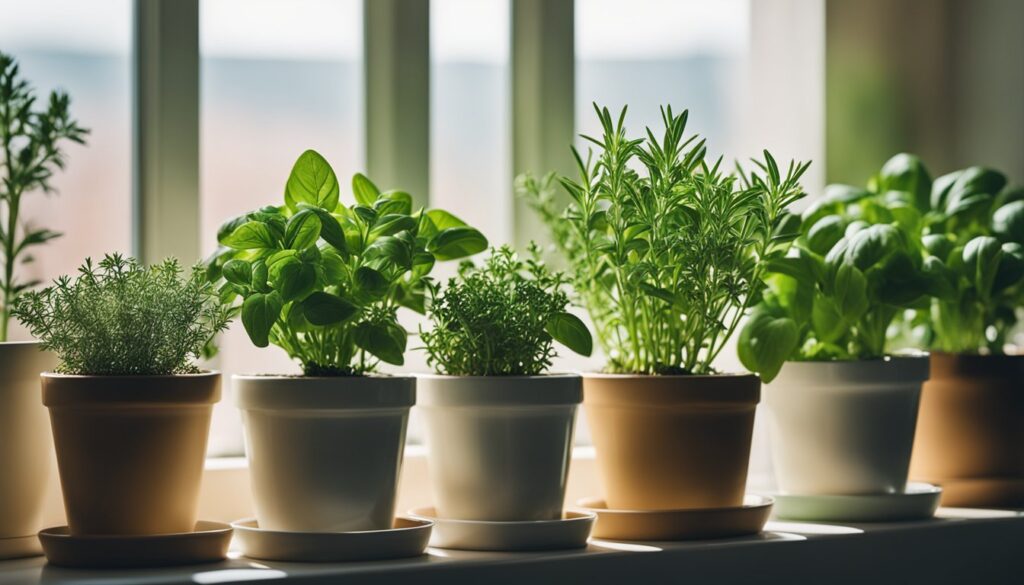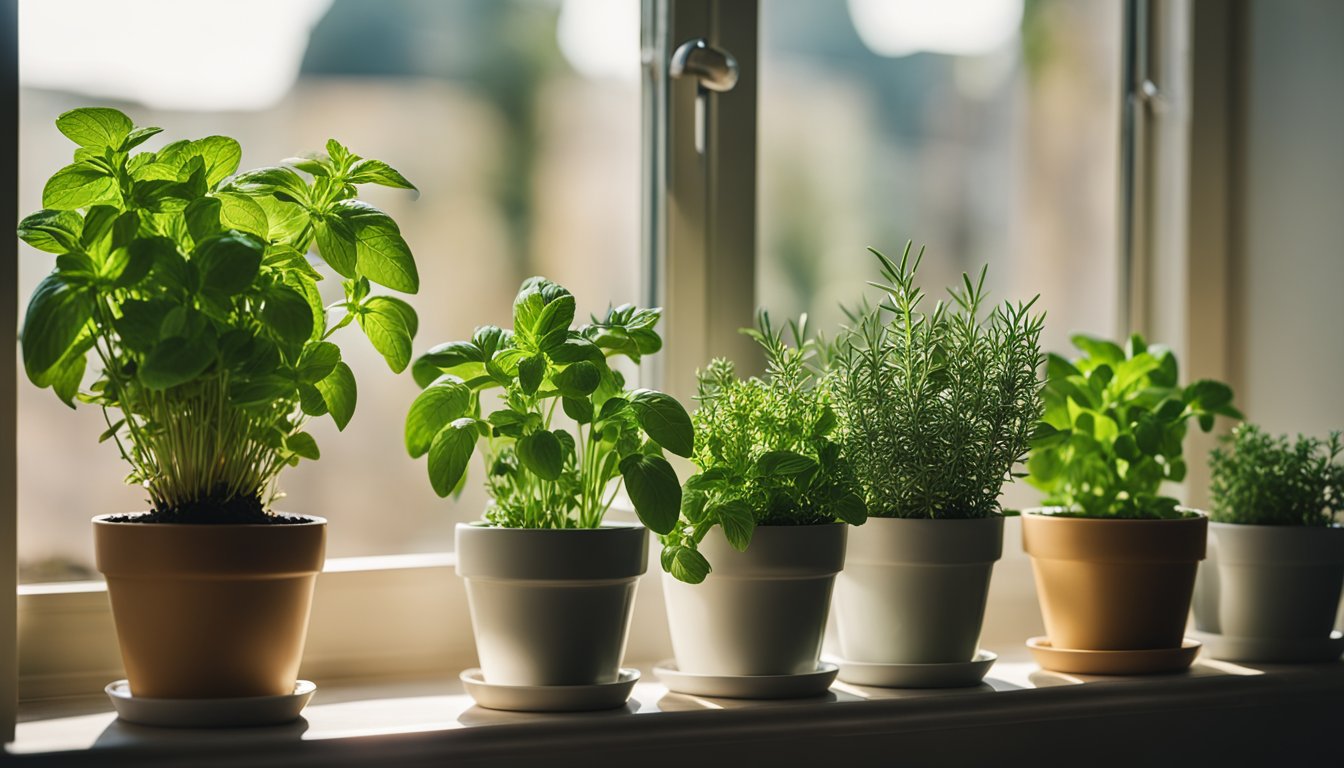What herbs grow indoors? I’ve always loved fresh herbs in my cooking. Their aroma and flavor are unmatched. But living in an apartment with no outdoor space makes it tough to have a fresh supply. Fortunately, growing herbs indoors is an easy and convenient solution for anyone who loves to cook with fresh herbs.
Creating an indoor herb garden is not only a practical way to have fresh herbs at your fingertips, but it is also a fun and rewarding hobby. With just a few simple steps, you can have a thriving herb garden in your home. You don’t need a lot of space or fancy equipment to get started. All you need is a sunny window, some good soil, and a selection of your favorite herbs.
When it comes to growing herbs indoors, there are several factors to consider. Choosing the right herbs is important, as some herbs are better suited for indoor growing than others. You also need to make sure your herbs are getting enough light, water, and nutrients to thrive. With the right care and attention, you can enjoy a bountiful supply of fresh herbs all year round.
Benefits of Growing Herbs Indoors

As an avid gardener, I find growing herbs indoors to be a rewarding and convenient way to have fresh flavors and scents year-round. Here are some of the benefits of growing herbs indoors:
Year-Round Availability
One of the main benefits of growing herbs indoors is that you can enjoy fresh herbs all year round. With proper care, herbs like fresh basil, oregano, parsley, rosemary, thyme, basil, chives, sage, and cilantro can thrive indoors, providing you with a constant supply of fresh herbs for your culinary creations.
Fresh Flavors and Scents in Winter
In winter, when the outdoor herb garden is dormant, growing herbs indoors can provide a much-needed boost of fresh flavors and scents. Fresh herbs are a great way to add flavor to soups, stews, and other winter dishes, and they can also help to freshen up the air in your home.
Convenient for Cooking
Growing herbs indoors is also convenient for cooking. You can easily snip off a few sprigs of fresh herbs whenever you need them, without having to go outside to the garden. Plus, fresh herbs are a healthier and more flavorful alternative to dried herbs, which can lose their potency over time.
Growing herbs indoors is a great way to enjoy fresh herbs year-round, add fresh flavors and scents to your home, and make cooking more convenient. With a little bit of care and attention, you can create a thriving indoor herb garden that will provide you with fresh herbs for years to come.
Choosing the Right Herbs to Grow Indoors
When selecting herbs to grow indoors, it’s essential to consider their specific needs and characteristics. Here are some key factors to keep in mind:
Perennial Herbs
Perennial herbs are a great choice for indoor gardening as they can thrive in a controlled environment. Herbs like rosemary, sage, thyme, and oregano are excellent options. These herbs typically require minimal maintenance and can provide a fresh supply of flavor-enhancing ingredients throughout the year.
Easy-To-Grow Herbs
For beginners or those with limited gardening experience, opting for easy-to-grow herbs is a wise decision. Herbs such as parsley, basil, and chives are relatively resilient and can adapt well to indoor conditions. They require moderate care and can flourish in a variety of settings.
Herbs That Tolerate Indirect Sunlight
When cultivating herbs indoors, it’s crucial to consider their light requirements. While some herbs thrive in bright, natural light, others, such as chives and mint, can tolerate indirect sunlight. Understanding the light preferences of different herbs is key to ensuring their successful growth in an indoor setting.
By carefully selecting a variety of perennial, easy-to-grow, and light-tolerant herbs, I can create a thriving indoor herb garden that provides a fresh and aromatic addition to my culinary endeavors.
How to Grow Herbs Indoors
Starting from Young Plants
When starting an indoor herb garden, I always prefer to begin with young plants rather than seeds. This allows for a head start and ensures a higher success rate. Young plants are readily available at local nurseries or can be propagated from cuttings.
Caring for Rooted Herbs
After I have my young plants, I carefully transplant them into well-draining containers with rich soil. I make sure to provide adequate water, avoid waterlogging, and maintain room temperature to ensure their healthy growth.
Providing Proper Sunlight and Watering
Placing the herbs in the sunniest spot in my home, usually near a south-facing window, ensures they receive ample sunlight. I water them when the soil feels dry, ensuring not to overwater as this can lead to root rot.
Tips for Continual Harvest
To ensure a continuous harvest, I prune the herbs regularly, promoting new growth. I also keep an eye out for pests and diseases, providing adequate air circulation to prevent any fungal issues. Additionally, I fertilize the herbs occasionally to maintain their vitality and flavor.
Bringing Herbs Outside During Warmer Months

As the weather gets warmer, it’s time to start thinking about bringing your indoor herbs outside to enjoy some fresh air and sunshine. However, before you do so, there are a few things you need to keep in mind to ensure your herbs thrive in an outdoor environment.
Transferring Herbs to a Garden
If you want to transfer your indoor herbs to a garden, you need to make sure you do so carefully. First, you need to acclimate your herbs to the outdoors by gradually exposing them to more sunlight and wind over a few days. Once your herbs are acclimated, you can transplant them to your garden.
When transplanting, make sure you choose a location that gets plenty of sunlight and has well-draining soil. Dig a hole that’s slightly larger than the root ball of your herb, and gently place the plant in the hole. Fill in the hole with soil, and water your herb thoroughly.
Protecting Herbs from Harsh Weather
It’s important to protect your herbs from harsh weather conditions such as frost, heavy rain, and strong winds. If you live in an area with frost, you should cover your herbs with a frost blanket or move them indoors overnight. If you’re expecting heavy rain or strong winds, you can use stakes or cages to support your herbs and prevent them from getting damaged.
Returning Herbs Indoors During Winter
When the weather starts to cool down, it’s time to start thinking about bringing your herbs back indoors. Before you do so, you need to make sure you inspect your herbs for any pests or diseases. If you notice any issues, treat them before bringing your herbs indoors.
Once you’ve inspected your herbs, you can bring them back inside and place them in a sunny window. Make sure you continue to water your herbs regularly and provide them with the right amount of light and nutrients.
Overall, bringing your herbs outside during warmer months can be a great way to enjoy fresh herbs in your cooking and make delicious pesto. By following these tips, you can ensure your herbs thrive in an outdoor environment and continue to grow strong and healthy.
Before You Go – What Herbs Grow Indoors?

Growing herbs indoors is a great way to have fresh and flavorful herbs at your fingertips all year round. With a little bit of knowledge and the right equipment, anyone can create an indoor herb garden.
When choosing which herbs to grow indoors, it’s important to consider the amount of light and space available. Some herbs, like basil and parsley, require more light than others, while herbs like mint and chives can thrive in lower light conditions. It’s also important to choose herbs that are well-suited to growing in containers.
To ensure success with your indoor herb garden, it’s essential to provide your herbs with the right growing conditions. This includes using a well-draining potting mix, providing adequate water and nutrients, and monitoring for pests and diseases.
Overall, growing herbs indoors can be a rewarding and enjoyable experience. Not only can it provide you with fresh herbs for cooking, but it can also be a fun and relaxing hobby. So why not give it a try and start your indoor herb garden today?
Linking “What Herbs Grow Indoors?” to The Herb Prof
Indoor herbs, let’s dig into them! They’re the green thumbs of the indoor world, bringing life to your home.
Now, you might be thinking, “What’s this got to do with The Herb Prof?” Well, let me tell you! The Herb Prof is your go-to guide for all things herbal. We’ve got the scoop on which herbs can grow indoors.
By linking our indoor herb discussion to The Herb Prof, we’re creating a greenhouse of knowledge. You learn about these wonderful herbs, and then you can hop over to The Herb Prof to learn even more about herbs and their uses.
References – What Herbs Grow Indoors?
Little Herb Encyclopedia, by Jack Ritchason; N.D., Woodland Publishing Incorporated, 1995
The Ultimate Healing System, Course Manual, Copyright 1985, Don Lepore
Planetary Herbology, Michael Tierra, C.A., N.D., Lotus Press, 1988
Handbook of Medicinal Herbs, by James A. Duke, Pub. CRP Second Edition 2007
The Complete Medicinal Herbal, by Penelope Ody, Published by Dorling Kindersley
Check the Following Articles!
Herbs That Grow In Sun: A Guide to Sun-Loving Plants
A Guide to Growing Indoors: Herbs That Don’t Need Sunlight
Herbs For Mosquito Repellent: 5 Must-Try That Work!
Frequently Asked Questions – What Herbs Grow Indoors?
What are the top herbs suitable for growing in an indoor garden?
Several herbs are suitable for indoor gardening. Some of the most popular herbs that can be grown indoors include basil, parsley, chives, thyme, rosemary, oregano, and mint. These herbs are easy to grow and can be used in a variety of dishes.
Which herbs can thrive indoors with limited natural light?
Some herbs that can thrive in low-light conditions include mint, parsley, chives, and thyme. These herbs do not require direct sunlight and can be grown in a sunny window or under artificial light.
What is the simplest herb for a beginner to cultivate inside?
Basil is one of the simplest herbs for a beginner to cultivate indoors. It is easy to grow and requires minimal care. Basil can be grown in a pot or container and needs a sunny location.
Can you list medicinal herbs that are easy to grow in an indoor environment?
Some medicinal herbs that are easy to grow indoors include aloe vera, chamomile, lavender, and peppermint. These herbs have several medicinal properties and can be used to treat various ailments.
What precautions should be taken when choosing herbs to grow indoors to avoid poor growth?
When choosing herbs to grow indoors, it is important to select herbs that are suitable for indoor gardening. Some herbs require more sunlight and space than others. It is also important to choose healthy plants and avoid plants with pests or diseases.
How can I maintain a year-round supply of herbs by growing them indoors?
To maintain a year-round supply of herbs, it is important to plant herbs at different times throughout the year. This will ensure that you have a constant supply of fresh herbs. It is also important to prune herbs regularly and provide them with adequate water and nutrients.

